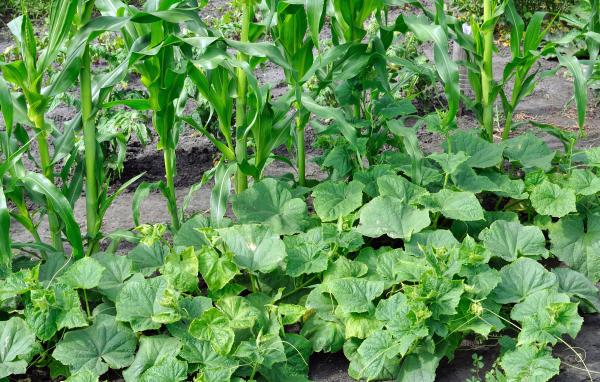Three Sisters: An Ancient Garden Trio

Several dozen educators, culinary experts, teachers, and school gardeners from Bay Area schools gathered at the Center for Ecoliteracy in Berkeley for four talks aimed at delving deeper into existing connections between practices in education and the natural world.
Wendy Johnson, a garden consultant to The Edible Schoolyard in Berkeley, spoke from 25 years of experience gardening, teaching, and meditating and mothering at Green Gulch Farm Zen Center. She discussed the importance of the "Three Sisters" to gardening in schools as a meaningful context for education.
What are the Three Sisters?
The Three Sisters include corn, beans, and squash. As part of the circle of life, these New World crops rely upon each other for survival. According to Iroquois — who chant "you who sustain us" to the trio — the Three Sisters hold a spiritual, ceremonial, and celebratory place in the garden. Not only are the Three Sisters rich in mythological, cultural, and botanical history, they belong together nutritionally. Corn, beans, and squash complement each other: corn for grain and carbohydrate, beans for protein, and squash for vitamin A.
Humans as Interdependent Contractors
Serving a dual function with respect to the Three Sisters, humans have both manipulated and preserved the crops for future generations. Johnson explained how beans evolved on all continents and were carried by messengers as currency and gifts. This complex distribution promoted the dissemination of these crops throughout the world, creating challenges for historians tracing the crops' origin. Human hands — primarily the dexterity of the thumbs to extract seed — helped the Three Sisters evolve into their present, varied forms.
Johnson expressed concern about humans' role in excessive seed crossbreeding. Hybrid crops endanger heirloom seeds — those passed down from our ancestors — because they outcross with other varieties so readily. "With so much hybridization, and now with genetic modification of these crops," she said, "it's hard to protect the heirloom varieties."
However, propagation of these staple crops secures an important role for humans who care, who sense the Three Sisters' circle of life: to diligently select, create, and protect heirloom seeds by growing these crops in our gardens. As Johnson said, "We're interdependent contractors."
Still, much of the knowledge about the history of these ancient Three Sisters is still unknown. Puzzles Johnson, "We're talking about a mystery here that we'll never completely understand."
Children Care for Three Sister Gardens
The Three Sisters remain wonderful crops to grow in school gardens. "Gardens are a completely natural home base for kids," Johnson said. "Gardens become a myriad of places to a child: a lab, kitchen, playground, and place of worship. A garden steers children into a diverse, spiritual world, since each seed or plant looks unique and distinct. Plus, gardens are beautiful."
Johnson shared two vivid experiences relating children and gardens. At Green Gulch Farm in Marin County, California, children set up a teepee at the center of the garden each year, made of bamboo poles. Crossed at the top to train wild beans, this sacred place remains off-limits to adults. Not only does the teepee physically take over the center of the garden, it also centers the kids with their own world inside. One year, they even placed acorn cups outside the teepee to give the birds a drinking station, further exploring the gardens' circle of life.
In another instance, Johnson helped the 6th-graders harvest corn at the Martin Luther King Middle School's Edible Schoolyard in Berkeley — an organic garden — integrated into the school's curriculum and lunch program. Each student went into the cornfield, stood underneath the rustling husks and found his or her sweet, jeweled ear. After harvesting the ears of corn, the children took them to the barbecue pit, doused the ears in water, and laid the corn out onto the fire (author's note: hear the hiss).
One child stood up and started to sing, creating an incredible rap (sody) celebrating the corn's spirituality and presence to the garden! Other children also danced and sang.
Weaving schools, gardens, and kitchens together remains a wonderful opportunity for students and teachers alike, says Johnson, to experience the natural world first-hand in the classroom.
Planting a Three Sisters Garden
If unoccupied outdoor space exists near your school, try planting a garden dedicated to the Three Sisters. Here are a few ideas:
- Keep beans near some form of support such as a chain link fence; they like to climb.
- Place corn and squash (pumpkins work well, also) into inner loose beds. Corn is a heavy feeder as it grows big and bushy, while squash protects the soil by covering the soil surface with its long, windy vines.
- Plant sunflowers at end of beds.
- If planting with children, don't change the way kids lay seed; you can't fix the natural world.
- Plant extra. Pilfered crops are to be expected — they reveal the power of these crops.
- Expect the Three Sisters to be unruly, despite efforts to control them. These gardens teach patience and express the natural world's complexity.
- Make beds fallow — unplanted for one growing season in order to enrich the soil — when you notice weaker plant growth.
Lastly, enjoy and appreciate the ancient beauty and unforgettable taste of the Three Sisters!
Those educators who attended Ms. Johnson's talk left with special favors of seed for personal or work gardens. Seed packets included Rainbow Inca Corn, Yugoslavian Heirloom Beans and Small Sugar and Rouge Vif D'Etampes Heirloom Pumpkin.

